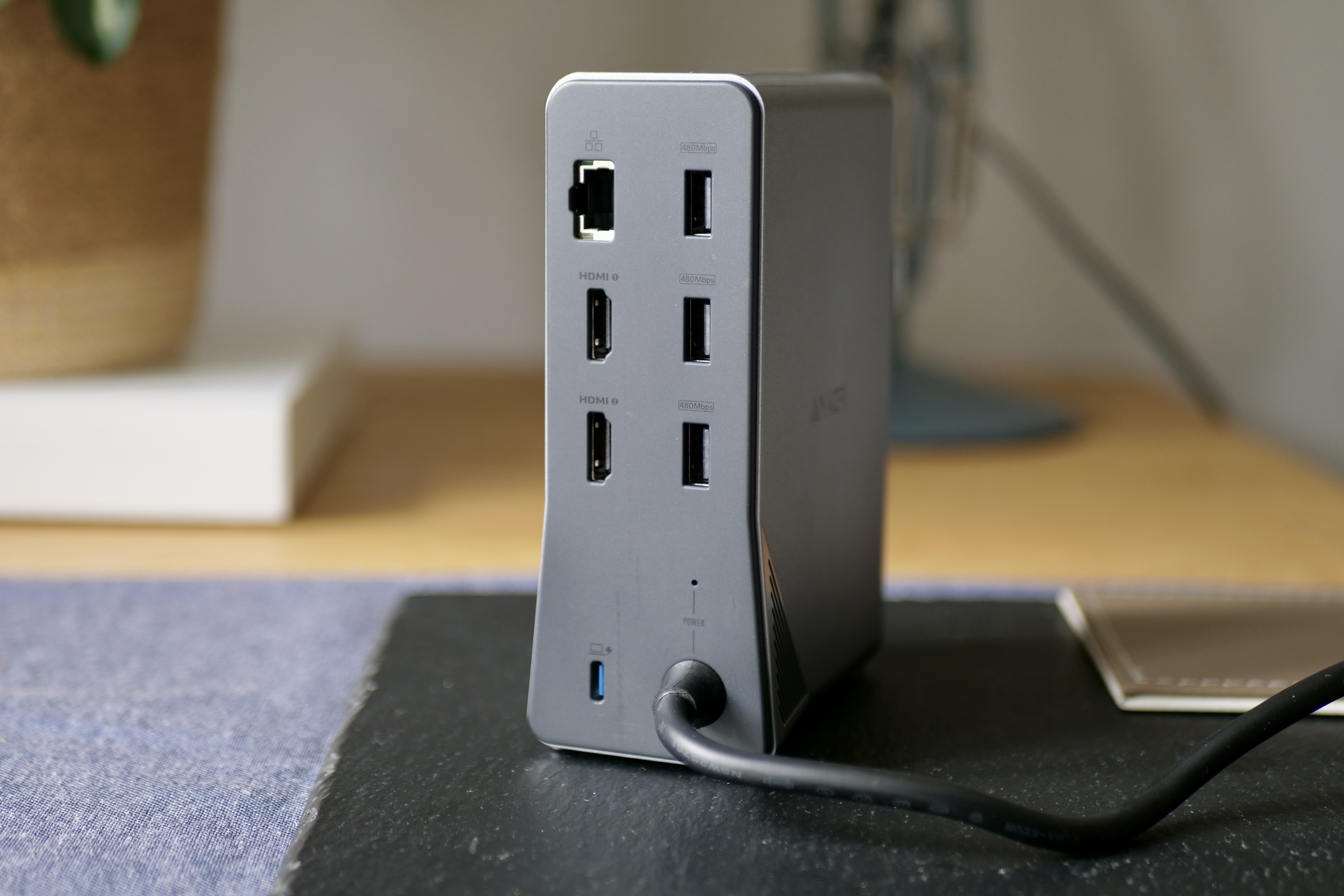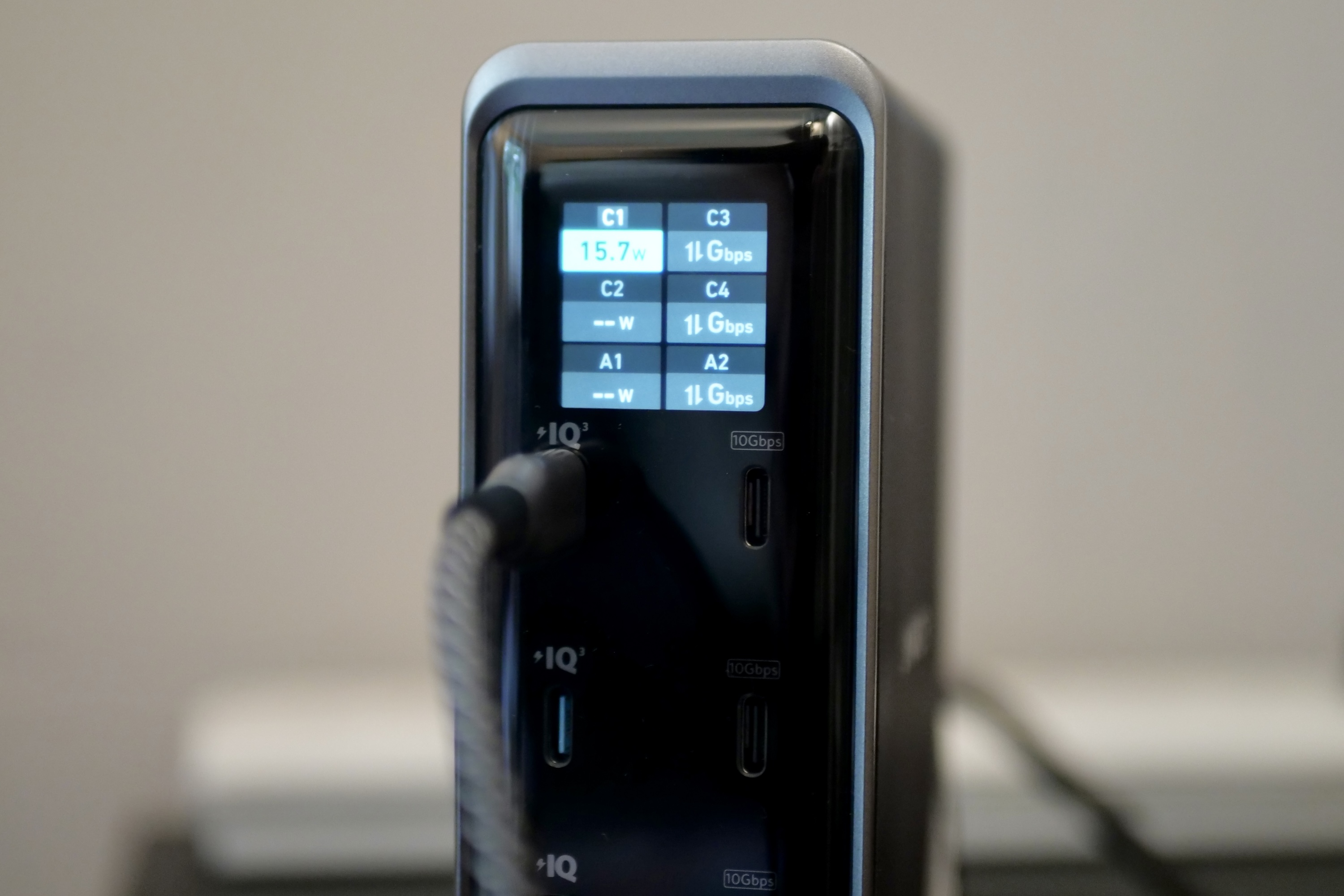All I want from a charger is for it to work when I plug something into it and for it to be convenient so that it fits with my lifestyle. When I received Anker’s new Prime Charger devices, I wasn’t sure at first whether any would really fit into my lifestyle, but I was wrong.
Once I started testing one out, I discovered it was exactly what my living room was missing.
Multiport charging

I’m talking about Anker’s new Supercharged Multi-port Desktop Charging Station, part of its latest Prime charger range. It’s a relatively small, but chunky GaN dock with six USB ports set in a piano black panel and surrounded by a ridged plastic body. On the underside are four rubber feet to keep it from slipping around, and on the back is a seriously thick removable AC power lead leading to the wall plug.
I charge a lot of different devices often and have, until now, made do with wall chargers plugged into extension leads and regularly unwrapped nests of USB cables that string across the floor while regularly forgetting which charger charged which device the fastest. The Anker Prime charging station solved this. It takes up a single plug in the extension lead, but has six ports of varying ability on the other end, with a total of 200W charging power spread across them.

There are two USB-A ports and four USB-C ports, all with Anker’s ActiveSheild 3.0 power and temperature protections and its PowerIQ 3.0 technology. This means it supports several USB charging standards, including Qualcomm’s Quick Charge, Samsung’s Fast Charge, and Apple’s fast charging. I can charge an individual device at up to 100 watts. The specification is impressive, but the reason I warmed to it is more about its convenience than its ability.
Life on the shelf

Extension leads are a pain. They slide around on the floor, and they mean cables are always snaking their way around the room. Mine are also inconveniently bundled down by the side of my couch. The Anker charger’s main power lead is more than a meter long, and I’ve found a convenient piece of shelf space for it in my living room, where it has changed everything. After I plugged it in, there were no more cables on the floor, and I no longer had to crawl around to either find the right cable, plug a new one in, or tidy them up.
It sits there, taking up very little space. It’s heavy at 561 grams, though, so it needs a sturdy shelf. I can immediately see what cables are plugged in, which ports are available, and if the device I want is on charge or not. Due to its huge power, I can charge everything I want from it, and it seems to deliver the fastest available speeds, too. It charges my Apple M1 MacBook Air without a problem, for example, meaning I don’t have to rely solely on the Apple charging block — I only own one — anymore.
Charging standards are confusing, and I wasn’t sure if the Anker charging station’s PowerIQ technology would handle Samsung’s fastest charging system, but the Galaxy Z Flip 6 shows “Super Fast Charging” on the screen when plugged into it, indicating it’s using the most amount of available energy. I’ve tested this with an older 100W Anker USB-C cable and its new 240W USB-C cable, and both activate Samsung’s fastest charging. It’s the same with the proprietary charging puck that comes with the Samsung Galaxy Watch 7, and I know the charging station works with Motorola’s TurboPower fast charging, as I also tried it with the Edge 50 Pro.
Other new Anker Prime products
The Supercharged Multi-port Desktop Charging Station isn’t the only new Anker Prime product coming out. I’ve also tried the new Prime Wall Charger, which delivers 100W charging across a pair of USB-C ports and a single USB-A port. Its folding wall socket prongs and convenient size make it handy for travel. Like the Charging Station, it activates Samsung’s Fast Charging and Motorola’s TurboPower.
The Anker 14-in-1 Workstation Dock is a far more complicated piece of hardware to integrate into your life, unlike the charging station and wall charger. It’s likely to be one of those products that directly solves a problem you are fully aware of rather than solving one you didn’t know you had in the first place.
Sitting vertically on the desk, the Workstation has two 10Gbps USB-C ports, a single 10Gbps USB-A port, and two 480Mbps USB-A ports, along with two 4K HDMI ports, an Ethernet port, and a 3.5mm headphone jack. At the top of the piano black front panel is a screen showing details on what port is charging, how much power is being used, and the data transfer speeds, with screens changed by pressing the top-mounted power button. The viewing angles are good, and it’s bright enough to be seen in a well-lit room.
Price and availability

When can you buy the new Anker Prime charging products, and how much do they cost? Let’s start with the Charging Station, which has been my personal favorite and costs $80, or 80 British pounds. It’s pricey for a charger, but considering the number of ports and the power available, it’s a decent value. The 100W Wall Charger is $85, or 85 pounds, while the new 240W USB-C cable costs $30 for a 3-foot version or $35 for the 6-foot cable. The 14-in-1 Workstation is a hefty piece of hardware for a hefty price, as it will set you back $250, or 200 pounds.
There is another new product in the Anker’s Prime range that I haven’t seen yet. It’s the 250W Prime Charging Station (seen in the image above), which is almost a hybrid of the Charging Station and Workstation. It has four USB-C ports on the front and two USB-A ports on the side, with a total power output of 250W. On the front is a screen showing charging speeds and power outputs, and a knob on the side lets you switch between different information panels. It costs $170, or 170 pounds. All of Anker’s new Prime charging products are available on Amazon starting today.
Problem solvers

Anker’s new Prime hardware has another common theme running across them all, and that’s the quality feel. Each product I’ve tried feels very substantial, with plenty of reassuring weight and hard-wearing plastic, along with solid cable connections for confidence. The 24-month warranty only adds to this feeling of getting a good product that the company believes in.
Chargers and workstations aren’t all that exciting, but for me, the Charging Station has easily fit into my life and solved a problem I hadn’t really thought about until now. It turned a situation I took for granted as “the way it is” and made it less of a pain, and because the hardware isn’t ugly or cheap, I can happily live with it on show in my living room.
I’ll take that kind of convenience over excitement, and I’m now contemplating ways to make good use of the even more technically impressive Workstation after this success.












